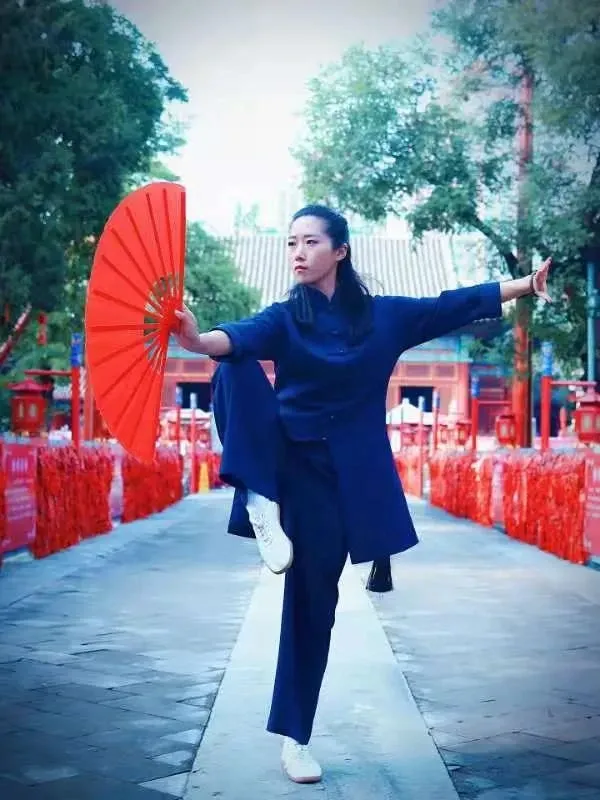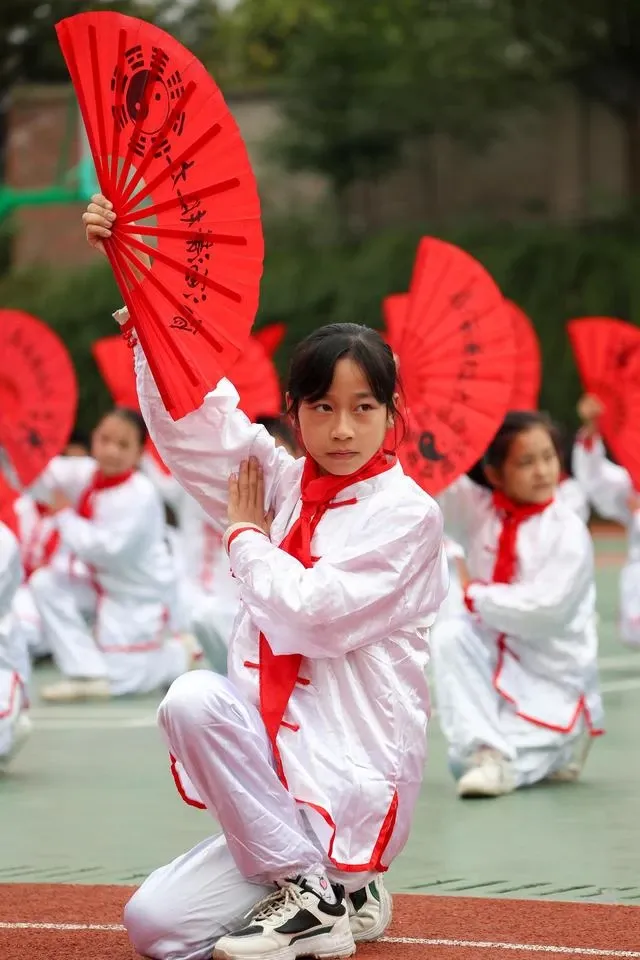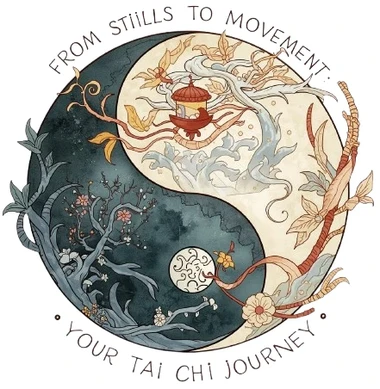Want to improve your balance, reduce stress, and learn a beautiful art? Tai Chi Fan (Taijishan) is your answer.
This guide gives you everything: how to start, which fan to buy, and the key moves—so you can feel the benefits faster.
Scroll down to grab your FREE Quick-Start Checklist!

What is Tai Chi Fan? The Harmony of Art and Martial Spirit
Tai Chi Fan, or Taijishan, is more than just exercise. It's a moving meditation. A graceful dance. A subtle martial art.
It combines three powerful elements into one practice:
- The Philosophy of Tai Chi: The principles of Yin and Yang—soft and hard, slow and fast, open and closed.
- The Precision of Swordplay: The attacking and blocking techniques of traditional Chinese swordsmanship.
- The Elegance of Dance: The flowing, expressive movements found in classical Chinese dance.
The result? A complete mind-body workout that is as effective for your health as it is beautiful to watch.
You don't need to be a martial artist or a dancer to start. Tai Chi Fan is designed for everyone. Its low-impact nature makes it perfect for all ages and fitness levels.
How to Choose the Right Tai Chi Fan for Your Practice?
Buying your first fan can be confusing. Do you need bamboo or steel? Heavy or light? Let's break it down in under 3 minutes.
Material Matters: A Quick Comparison
Your fan's material changes everything. Here’s the simple breakdown.
- Bamboo: Lightweight & traditional. Best for beginners. It creates a loud, satisfying "snap." It's the classic choice for a reason.
- Plastic/ABS: Durable & affordable. Won't break if you drop it. Perfect for daily practice in the park. A modern, practical option.
- Stainless Steel: Heavy & advanced. Used for strength training. Too heavy for beginners and can cause strain.
Choose bamboo or plastic to start. You can always upgrade later.
The 3-Step Selection Checklist
Don't overthink it. Just follow this list.
- Check the weight. Pick it up. A good starter fan weighs 300-400 grams. It should feel substantial but not heavy.
- Test the grip. Hold it like you mean it. The handle should be smooth. It must not rub or feel awkward in your hand.
- Listen to the sound. Open and close it. A clean, sharp "snap" means it's well-made. A weak sound means poor construction.
❗ Expert Tip: "A beginner with a fan that's too heavy will develop poor form. Start light, master the technique, then advance." — Taichi Wuji Master.
For 95% of beginners, a 13-rib bamboo fan is the perfect start. It's light, sounds great, and helps you learn correctly.

What Are the Step-by-Step Tai Chi Fan Moves for Beginners?
Let's get you moving. Here are the foundational moves. Practice without the fan first. Get the posture right.
Stance First: The Foundation of All Moves
Your power comes from the ground up. Master these two stances.
- Horse Stance (Ma Bu): Stand with feet wide. Knees bent. Feel your weight sink down. This builds powerful leg strength.
- Bow Stance (Gong Bu): Step one foot forward. Bend the front knee. Keep the back leg straight. This is for powerful forward movement.
Practice shifting between these stances. Smooth transitions are key.
Your First 3 Fan Moves to Practice Today
We'll go step-by-step. Ready?
1. Commencing Form (Qishi)
This is how every routine begins. It centers your mind and body.
Steps:
- Stand with feet together. Hold the closed fan in your right hand.
- Step left into a small horse stance.
- Bring the fan to your chest, both hands holding it gently.
Focus: Slow, deep breathing. Feel calm and grounded.
2. Open & Close the Fan (Kai He Shan)
This is your most important drill. It teaches control.
Steps:
- Hold the fan with both hands, thumbs on one rib, fingers on the other.
- Push with your right hand, pull with your left to open it smoothly.
- Reverse the motion to close it with a crisp snap.
Focus: Make the movement fluid, not jerky. Practice this 10 times.
3. White Swan Spreads Wings (Baihe Liangchi)
This is a beautiful, classic move that improves balance.
Steps:
- From a bow stance, open the fan with a wide, circular motion.
- Lift the fan in an arc above your head.
- Your other hand presses down gently.
Focus: Keep your movements fluid, like a bird's wings. Don't rush.
Progression Tip: Practice Move 1, then add Move 2. Then link Move 1, 2, and 3 together. You are now doing a mini-routine!
What Are the Proven Health Benefits of Tai Chi Fan?
This isn't just a pretty dance. The health benefits are backed by science and centuries of practice.
The Physical Power: Beyond Balance
This practice builds a stronger, more resilient you.
Boosts Balance & Prevents Falls.
The single-leg stances are powerful. A 2019 Beijing Sports University study confirmed it. Tai Chi Fan activates cerebellum function, drastically improving stability.
The Science: The constant weight shifting and narrow stances challenge your proprioception (your body's ability to sense its position in space). This trains your nervous system to react more quickly to stumbles, significantly reducing fall risk, especially in older adults.
Joint-Friendly Cardio.
No running or jumping. The circular motions give your heart a workout. All without pounding your knees.
The Science: The continuous, flowing movements keep your heart rate in a moderate, aerobic zone. This improves cardiovascular health and circulation without the high-impact stress associated with running or jumping sports. It's ideal for those with arthritis or joint pain.
Enhances Full-Body Coordination.
Your brain has to sync your hands, feet, and the fan. This creates new neural pathways. You become more agile.
The Science: Performing complex, multi-limb movements (like moving your feet in one pattern while your hands manipulate a fan in another) is a cognitive workout. It strengthens the connections between your brain and muscles, leading to better overall coordination.
You will feel more stable and coordinated in weeks.
The Mental Clarity: Your Anti-Stress Tool
The benefits go deep into the mind.
It's Moving Meditation.
You can't think about your deadlines. You must focus on the fan's path. This mindfulness reduces cortisol, the stress hormone.
The Science: The required focus on breath and movement pulls you into the present moment, a state often referred to as "flow." This has been shown to lower levels of cortisol, reduce anxiety, and improve overall mood.
You build confidence and artistry with every mastered move.
It is a powerful mood booster.
The Science: Achieving physical goals and learning a skill releases dopamine, the "feel-good" neurotransmitter. The artistic expression of the fan movements also provides a creative outlet, further enhancing emotional well-being.
❗Case Study Conclusion: *"After 12 weeks of Tai Chi Fan practice, participants in a senior community program reported a 30% reduction in stress levels and a marked improvement in their overall sense of well-being."*
The verdict is clear. Tai Chi Fan is a holistic mind-body workout. It is especially effective for seniors, office workers, and anyone seeking a peaceful way to get fit.
A Journey Through Time: The History and Philosophy of Tai Chi Fan
To truly understand the fan, we must look to its roots.
From Courtly Accessory to Martial Tool
The Chinese fan has a history of over 3,000 years. Initially made from feathers and plants, it evolved into a symbol of status and art in the Han Dynasty, with beautiful silk "round fans" or "Tuan Shan."
But how did it become a weapon?
Martial artists in ancient China were masters of improvisation. They learned to use everyday objects for self-defense. The folding fan, with its rigid ribs and sharp tip, was a perfect candidate. It could be used to:
- Poke like a short sword.
- Parry like a shield.
- Strike with the hard edge of the ribs.
The fusion of this practical weaponry with the internal power and philosophy of Tai Chi created what we now know as Tai Chi Fan.
The Core Philosophy: Yin and Yang in Your Hand
Every movement in Tai Chi Fan embodies the concept of Yin and Yang.
- Opening the fan (Kai) is Yang - an expansion, an expression, an outward energy.
- Closing the fan (He) is Yin - a contraction, a withdrawal, a storing of energy.
- A slow, flowing movement (Rou) is Yin.
- A fast, powerful snap (Gang) is Yang.
The practice is a constant dance between opposites. This is why it feels so balanced and complete. You are not just training your body; you are embodying a fundamental principle of the universe.
What Are the Main Styles of Tai Chi Fan?
There's more than one way to wave a fan. Understanding the styles helps you find your path.
Chen Style: The Powerful Root
This is the oldest style. It is dynamic and martial.
Key Features:
- Spiraling Power: Movements are wrapped and coiled.
- Explosive Releases: Sudden bursts of power.
- Low Stances: Strong, grounded postures.
Best for: Those who want a traditional, challenging, and martial-focused practice.
Yang Style: The Graceful Flow
This is the most popular and widely practiced style. It is graceful and accessible.
Key Features:
- Steady & Expansive: Movements are large and flowing.
- Even Pace: No sudden speed changes.
- Upright Posture: Gentle on the joints.
Best for: Beginners, seniors, and anyone focused on health, relaxation, and graceful movement.
Modern & Performance Styles
- Tai Chi Kung Fu Fan: Created for fitness and to support Beijing's 2008 Olympic bid. Often performed to powerful music. Energetic, crowd-pleasing, and designed for group displays.
- Lotus Fan: Created to celebrate Macau's return to China in 1999. Very dance-like and beautiful, often performed with two fans. Great for group performances.
- Four-Dimensional Fan: A modern hybrid. Blends internal Tai Chi with external martial arts techniques. Known for its 38 precise and martial-oriented postures.
Not sure? Start with Yang Style. Its gentle, flowing nature is perfect for building a strong foundation.
How to Learn a Complete Tai Chi Fan Routine?
You've mastered a few moves. Now, let's string them into a routine.
Popular Routines to Explore
- 28 Form Yang Style: Short, sweet, and perfect for beginners. Your ideal first routine.
- 48 Form Chen Style: More complex. Includes jumps, spins, and fa jin (power releases). A challenge for experienced practitioners.
- Tai Chi Kung Fu Fan (1st Set): Energetic and fun. Often performed to the song "Chinese Kung Fu." Excellent for cardio and group energy.
Your 4-Step Learning Strategy
This method prevents overwhelm.
- Pick One Routine. Don't bounce around. Commit to learning the 28 Form first.
- Break It Down. Learn 3-5 moves at a time. Master them before moving on.
- Use Video Resources. Search for "[Routine Name] tutorial" on YouTube. Watch, pause, and mimic.
- Practice Consistently. 15 minutes daily is better than 2 hours once a week.
The goal is progress, not perfection. Consistency turns slow practice into fluid mastery.
Your Next Step: Download Your Free Resource
You now have the blueprint. You know which fan to buy, the moves to practice, and the benefits you'll gain.
But knowing isn't the same as doing.
To make your start effortless, we've created the "Tai Chi Fan Quick-Start Checklist." This printable PDF breaks down everything from today's guide into a simple, step-by-step action plan.
- Fan Buying Guide (At-a-Glance)
- Beginner Practice Schedule
- The First 10 Moves, Broken Down
- Troubleshooting Common Mistakes
Click Here to Download Your FREE Quick-Start Checklist Now!
Start your journey today. Unlock the power, grace, and peace that Tai Chi Fan offers.
Did you find this guide helpful? Share it with a friend who might love Tai Chi Fan!
Frequently Asked Questions (FAQ)
Is Tai Chi Fan suitable for seniors?
Absolutely. It is one of the best exercises for seniors. Its low-impact nature protects joints while dramatically improving balance, strength, and cognitive function, directly addressing key concerns of aging.
Can I learn Tai Chi Fan by myself from online videos?
Yes, you can get started. Online videos are a fantastic resource for beginners. However, hiring a teacher, even for a few online sessions, is highly recommended. A teacher can correct subtle mistakes in your posture and alignment that videos cannot, preventing bad habits and potential injury.
How is Tai Chi Fan different from regular Tai Chi?
The fan adds a new dimension. Weight and Resistance: The fan makes your arms work harder, building upper body strength. Technical Complexity: Manipulating the fan (opening, closing, spinning) adds a layer of coordination. Martial Application: The fan introduces specific weapon techniques like thrusting, cutting, and blocking. Artistic Expression: The visual and auditory element of the fan makes the practice more expressive and performative.
What should I wear for practice?
Wear loose, comfortable clothing that allows for a full range of motion. Flat, flexible shoes (like kung fu shoes or sneakers with thin soles) or bare feet are best, as they allow you to feel the ground.
